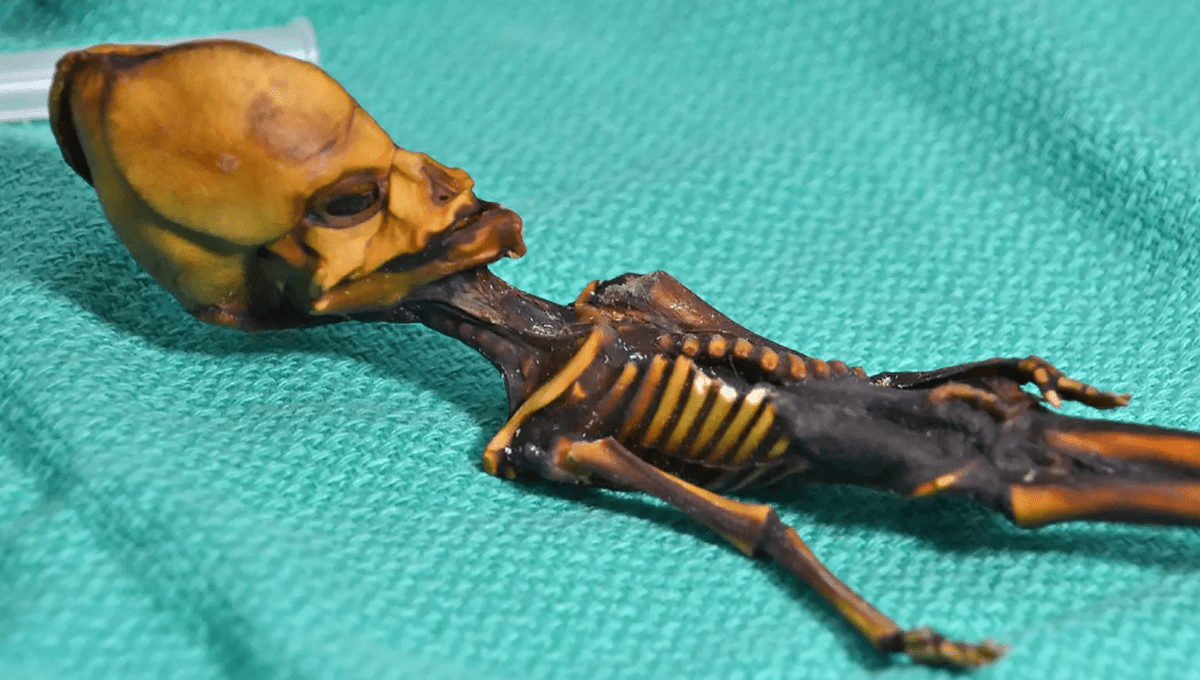
The Atacama Skeleton continues to stir controversy and confusion. Discovered in Chile’s Atacama Desert back in 2003, the 15-centimeter (6-inch) long mummified skeleton features an unusually long skull, giant eye sockets, and only has only 20 ribs instead of 24.
What is the Atacama Skeleton?
The skeleton gained the nickname “Ata.” When the images hit the internet, many people jumped to the conclusion this was the body of an extraterrestrial alien. A 2013 documentary called Sirius claimed the skeleton belonged to a 1,000-year-old being that was evidence of contact between aliens and ancient civilizations.
However, in 2018, a genetic analysis of Ata’s bones quashed these rumors by establishing the skeleton was a premature human fetus. In fact, they were a female of South American descent. An exact age couldn’t be pinned down, but the researchers said their study showed the mummy was 500 years old or less.
On top of this, it was found that their DNA contained seven genes associated with bone and facial malformation, premature joint fusion, and dwarfism. The mutations linked to dwarfism and a rare bone aging disorder likely explained the skeleton’s unusual appearance.
This study has proved controversial, however. In a rebuttal to the genetic analysis, another team of scientists claimed that genetics probably has little to do with Ata’s appearance and, instead, the elongated skull was the result of a complication during pregnancy or birth, or as a result of the mummification process.
They also argued that the genetic analysis was riddled with ethical issues, stating there was no scientific rationale to disturb the remains.
“Unfortunately, there was no scientific rationale to undertake genomic analyses of Ata because the skeleton is normal, the identified genetic mutations are possibly coincidental, and none of the genetic mutations are known to be strongly associated with skeletal pathology that would affect the skeleton at this young age,” commented Associate Professor Siân Halcrow, a bioarchaeologist at the University of Otago.
How was the Atacama Skeleton discovered?
The story of the Atacama Skeleton’s discovery is hazy and explains why studying the mummy is such a contentious issue.
So the story goes, it was discovered by a treasure hunter called Oscar Muñoz in 2003 next to an abandoned church in a ghost town called La Noria. He claimed it was found wrapped in a white cloth inside a leather pouch.
Years later, Ata ended up in a private collection in Barcelona, according to The New York Times. The Chilean National Monuments Council alleged that the remains were illegally exhumed in 2003 and smuggled out of the country.
In light of the dubious backstory of Ata, many scientists questioned whether the genetic studies of the skeleton were ethically sound, not least because the skeleton may have been obtained illegally.
Chinchorro mummies
There is a very similar mummified human fetus known as Alyoshenka that was discovered in Russia in 1996. However, for the Americas, Ata is unique.
That being said, the Atacama Desert is home to a number of mummified human remains. The Atacama Desert is an achingly arid, skinny strip of desert on the west coast of South America that’s the driest nonpolar desert in the world. Conditions are so harsh in this rocky landscape that scientists have used the area to simulate missions to Mars.
Human remains that are buried here will be naturally mummified due to the intense heat and lack of moisture. It is also known, however, that the ancient Chinchorro culture had a tradition of intentionally mummifying bodies in the Atacama Desert to venerate their dead.
Bodies were mummified through a variety of complex embalming processes. One technique involved extracting the brains and organs, then stuffing the body with fiber and filing the skull with straw or ash, before sowing the body back together with reeds. Finally, the mummy was caked with a thick muddy paste.
Source Link: Why Is The Atacama Skeleton So Controversial?